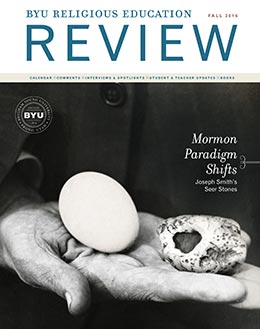Fall 2016 brings significant changes in Religious Education as we welcome seven new faculty members: two in the Department of Church History and Doctrine and five in Ancient Scripture. Biographies of the new faculty members will appear in future issues of the Review. Our new faculty members bring new research specialties, excellence in teaching, impressive publications, and the hope of a bright future.
In this issue of the Review, we draw your attention to some promising research that is ongoing and in several cases is also nearing publication. With a longer perspective in mind, Rachel Cope is beginning work on a database of nineteenth-century sermons that includes transcriptions of many previously unpublished sermons. The work involves a host of student transcribers who are working at various institutions across the United States. This project promises to provide new insights into contextualizing early American religious life as well as contextualizing the Restoration. Lincoln H. Blumell and a team of scholars across BYU campus is nearing publication of the HBLL’s important papyrus containing a commentary from Didymus the Blind (died 398 CE). The papyrus is perhaps the HBLL’s most important papyrus in its collection, and has been at BYU since the 1980s. Also, Michael MacKay and Nick Frederick recently published with the RSC a new book about Joseph Smith’s seer stones, and in this issue of the Review he gives us a glimpse of seer stone culture in nineteenth-century America. I would also draw your attention to Mark D. Ogletree’s article on David O. McKay as a father. Mark did much of the research for this book as a PhD student at Utah State University.
As always, there are many exciting projects that are not highlighted in the Review, but I hope that what is included will give you a feel for the excellent research and teaching that is taking place in Religious Education. We have an exciting array of publications that highlight the growth of the Church across the globe. Other recent RSC publications that you may find interesting are A Reason for Faith: Navigating LDS Doctrine and Church History, A Historian in Zion, and Provo’s Two Temples. We continue to strive to publish the best works on LDS history, doctrine, and scripture and to make those works as broadly available as possible. Finally, we would like to draw your attention to our 2017 release of the Religious Educator in digital format. Starting in January 2017, the Religious Educator will be available in both print and digital format, and we will also expand access to older issues of the journal. For more information on the Religious Educator, please visit rsc.byu.edu.
Thomas A. Wayment
Publications Director
Religious Studies Center
